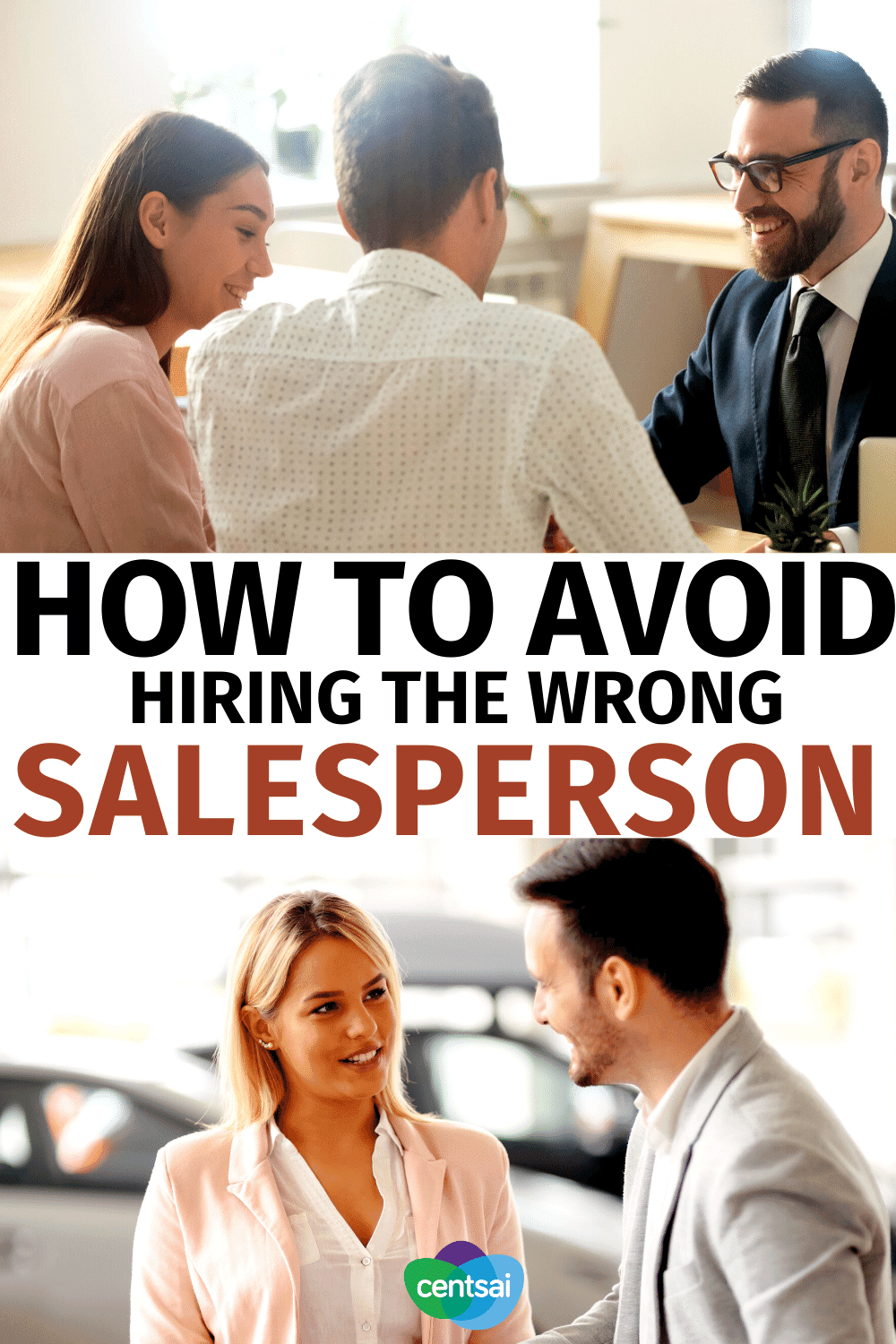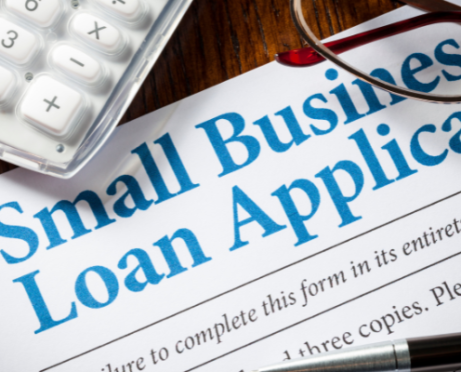
 If you’re growing a small business, sooner or later, you’re going to think to yourself, “If I hire a salesperson, I’ll make more sales and grow!”
If you’re growing a small business, sooner or later, you’re going to think to yourself, “If I hire a salesperson, I’ll make more sales and grow!”
Before placing ads for hire in the digital newspaper, ask yourself if the idea of hiring a salesperson stems from feeling anxious for more sales or if you’re facing this decision because it seems like the natural next step in your business’ growth.
Before I go any further, I have to tell you that in most cases, when my clients entertain hiring a salesperson for the first time, it’s often in response to a feeling of wanting to find a magic bullet to grow their sales. It turns out, that what they really need is to fix a broken sales process, not hire a salesperson.
The last thing you want to do is to hire a salesperson who makes a broken process go faster and produce no results. I should know. I’ve been there and done that with my previous company, Butter Beans, which I’ll tell you more about in a minute.
After making sales mistakes and taking over three years to start making money in my business, I finally discovered the trick that works for many companies large and small, including Microsoft who reached $100 billion in revenue for the first time in 2018.
I didn’t make $100 billion in sales, but I did figure out how to simplify my process from studying others and not only did I turn my business into a profitable company, I grew my sales consistently year over year: steady growth of 25 percent to 50 percent every year since I figured it out.
I call it the BEL Method. I’m going to teach you the three simple strategies of this method in this article. By the end, you’ll know if your next step is to go forth and hire a salesperson.
The Backstory
Early on when I was running Butter Beans, a company that provides healthy school lunches, my sales were just enough to not lose money.
In other words, we were paying our bills, but there was nothing left over. It wasn’t our first year, or second year; it was our third year in business and I paid myself only a small salary even though I was working what felt like 80 hours, seven days a week. Up until this point, I had good clients, but my business felt like more work than reward.
It made me question everything and I was burning out. Was this gig going to work? Was all this work for the past 30 months for nothing? I lost a lot of sleep during this time trying to figure out how to make it work. Despite concerns, my clients kept me going. I knew my idea was good because people loved the service, I just needed to get over the hump.
And like my clients now, I thought hiring a salesperson was the key to getting over that hump.
So, I hired a commission-only salesperson. She was so excited. She absolutely loved the product, the mission, the cute logo, everything about us. She couldn’t wait to get to work. I gave her my lead list including the one lead that was about to close. I wanted her to be motivated and since she was commission only, I wanted her to get paid to keep her inspired.
She started out super enthusiastic with ideas about brand awareness in the marketplace, friends of hers whose parents wanted our lunches in their kids’ schools, and the list of over 100 leads I provided. She worked 20 hours a week, sending out emails, signing us up for a Sustainability Trade Show targeting schools, hunting down anyone who may be interested in our service. She called me about six months in and told me about a hot lead that she was sure to close.
I was super psyched, it seemed to be working, and so I asked for details. Then, she told me it was a daycare with about 30 kids.
My excitement quickly turned to reality that this wasn’t really working at all. Our target market was kids, but it was school-aged children, not 3-year-olds. Our ideal client was a school with at least 200 students so that we could get 100+ new lunch eaters per location.
This was critical for our economies of scale to work with our business model. Thirty meals weren’t going to pay a very big commission and after paying her, we would barely break even from taking on this new client.
After nearly a year of working with her, I realized, we weren’t ready for a salesperson, even if they were commission only and didn’t technically cost us anything.
Fortunately, in my case, my salesperson also realized that this was not working, and we mutually agreed to part ways. She needed a job that would pay her a steady paycheck and I needed to figure out my sales process so that regardless of who was selling, we were bringing on the right customers.
When I look back on this situation to reflect on why I thought I needed a salesperson, it really comes down to feeling like I was doing something wrong and not enough, and that I needed more sales activity.
After my salesperson left, I analyzed everything that went wrong and everything that was going right with the customers I already had. This analysis clarified for me my three-step BEL Method.
Join the P2P Community For Free
Know Your Buyer on a Deep Level
The B in BEL stands for Buyer.
As a little girl, I grew up in an entrepreneurial family in North Carolina. I started working when I was around 12 years old, for my grandparents on their farm. I had my first sales experience there, selling luscious, sweet, mouthwatering blackberries and other farm fresh vegetables that I’d helped harvest in the garden.
This experience taught me about the B in the BEL Method and the importance of understanding the attributes of who was buying our products and exactly what we needed to satisfy their needs.
My Granny knew every detail of who her buyer was and what they cared about. She spent time in long conversations with them about how they used the food they bought from her, how they made their shopping lists and how they felt about their purchases after they’d gotten home from the market.
She didn’t call it this, but she was traveling the customer’s journey. She also listened as they shared family stories, and they genuinely liked my Granny. The key here is to figure out how to earn your customers’ trust and get them to like and know you, so they’ll think of you when they’re buying what you’re selling.
Twenty-five years later, when I was struggling at Butter Beans, I was so focused on getting more clients, that I neglected to make sure my salesperson was crystal clear on who our buyer was.
Our buyer had specific attributes, which included a minimum number of students of a certain age. When she showed up with a 30-person-per-day contract with preschoolers, I realized I hadn’t been clear about who our buyer was.
I didn’t want to disappoint the salesperson, so I took on a client that was not good for our business model; after 18 months, after she had moved on, the client and I agreed it wasn’t a good fit.
When I stopped focusing on bringing on any client and started focusing on bringing on the right clients, I remembered to ask my clients for referrals and to be references.
When they introduced me to other School Operations folks from similar-sized schools, the sales process was smoother and less onerous than the one I’d tried implementing before. This enabled me to double my sales in that fourth year and finally move past break even.
By having Strategy #1 in place — in other words, by knowing your Buyer deeply — it’s possible to get more qualified leads in the pipeline.
Look at Microsoft, my example from the beginning. Think about their ads and who they’re talking to. Smart people of all ages looking to get things done efficiently while having fun doing it. If you do bring on a sales team member , you must train them on exactly who your buyer is and how to communicate with them, so they continue to know, like and trust you.
You Must Know Each Element of Your Sales Process
Strategy #2 is E: The E in BEL stands for the elements of your sales process. Know it in enough detail that you can write it down and train it, so that another person besides you can execute it correctly.
If you’ve ever held any kind of sales job in high school or college, you can relate to this next story. I waited tables at a steakhouse, and we had competitions on who could upsell the most brownie sundaes. We wanted to get the average ticket as high as possible, so selling dessert was important, and I quickly realized, it was a process.
As a waitress who wanted to sell more dessert, I couldn’t just rely on the customers asking for it off the menu, I had to convince them to admit they wanted it and get everyone on board so they would buy it. I had to get them from, “no, I don’t need dessert,” to “Ok, we’ll take two spoons and share” as quickly as possible.
Whether it’s sundaes or getting your parents to let you take out the car, everyone has been through a sales process that works.
Now’s the time to figure out what your customers are going through to say yes to your products and services.
To illustrate an example of how the E works, determining the Elements of the sales process, I’ll walk through the steps of my first job out of college where I worked as a sales assistant for a solopreneur engineer.
My boss developed tiny lasers with microscopes that were components used by technology companies like IBM and Intel in their hardware products. He gave me a list of over 100 companies that we were prospecting.
He taught me each step of the sales process, which started with a script of what to say to someone the first time I got them on the phone. Since I was not a technologist and had no idea how our product worked, my boss wrote the script.
Start Your Free Trial with P2P Today
My job was to get us an in-person meeting with any company on that list so he could take over. Oftentimes, I had to call a few times to get to speak to the right person. These follow-up calls were strategic in getting us to the next sales stages, and I would get certain information from my boss after each one.
Fortunately for the company, I got us a high-level meeting at IBM Canada and my boss closed a sale for $100,000. In 1997 that was a lot of money, we made our year with that one sale, and he was able to continue his venture.
This experience of following his scripts shows the value of breaking down the sales process. Writing it out helps you better understand the process your leads go through to say yes. This example also shows the difference between a sales assistant, my role, and the closer, his role.
Looking to combine these early career lessons learned with practices of an established sales organization like Microsoft, I found articles about how they sell their software so I could understand their success.
What I found is that their salespeople are under a ton of pressure to make their revenue goals and that what made them successful was near perfect execution of each Element of their well-defined sales process. Broken down, their process incorporated strong relationships between the salesperson and the customer.
Next, their process was for the salesperson to clearly understand the clients’ challenges. This was followed by the job of outlining and effectively communicating how Microsoft’s solutions met the challenges and added value so that the client was better off.
Lastly, after the sale closed, the sales process continued. The salespeople then stayed in communication with the clients so they could continue to make sure they used all the bells and whistles that they had purchased.
This helped in securing the renewal the following year. Their former VP of worldwide sales, Kevin Johnson, even wrote a book about it called The New Solution Selling. If you’re doing well at selling, you’re probably doing all these steps even if you don’t notice.
This is a reminder not to take for granted all that is going on so that when you do hire someone, you don’t skip any of what you’re doing well and you train the new person.
The L in BEL: Location, Location, Location
Now, let’s talk about the L in BEL: location.
Knowing the location of where to find your ideal customers when building your pipeline is not just for real estate.
Before Butter Beans, I experimented with a retail pop-up shop selling fashionable women’s clothes in Greensboro, NC. I wanted to bring the NYC shopping experience to my hometown. But after one weekend of speaking to 200 local shoppers, I learned that they were happy shopping at Target and local shops for all their looks; they didn’t desire the experience or price tag of the designer clothes that I was offering.
Both the pop-up boutique and Butter Beans taught me the importance of location. Greensboro was not the right place to find buyers for the NYC shopping experience; however, NYC was the perfect place for finding foodies who wanted their children to have fresh, hot, homemade lunch at school each day.
Where do your clients hang out? Are they online? Are they in a specific physical location? Are they members of the same club? Live in a certain city?
When I had Butter Beans, my first clients were introduced to us by parents whose children attended the schools. Later, the schools themselves became a referral source. Stay in tune with where you can find leads as your business grows and ask for meetings and introductions.
Now that you have the secret behind the BEL Method, here is a recap in the form of a self-assessment.
Self-Assessment — Are You Ready for a Salesperson, an Assistant, or Neither?
To determine your next steps for hiring a salesperson, I’ve created a seven-question self-assessment. There’s a chance you know more about this than you realize. If you feel stuck, make a note, and come back to that question when it makes more sense to you. This is normal.
- How much time is there between the time you meet a prospective client to the time they decide to say yes for the top 80 percent of your deals? Is it 1 week, 1 month, 6 months, 3 years? There is no right answer, so focus on what is right for you.
- What are the steps in walking the client through the buying process? Some examples you may come up with: meeting them face to face, getting past a gatekeeper, presenting to a final decision maker, knowing there are iterations of a statement of work, following an RFP, etc.
- How many sales do you want to close in the next 3 months? 6 months? 9 months? 12 months? Answer this in dollars and in the actual number of clients per quarter. If you know this answer quickly, congratulations, you already know what you’re working toward and what success looks like for you. If you don’t know the answer to this, you’ll want to give this some thought. If you need a place to start, look at your sales for each quarter last year.
- What is the dollar range for contracts for your ideal client? From $______ to $______. If you serve multiple sectors, pick one that you most want to serve.
- How many prospects are in your pipeline? If you hold this info in your head, today is the first day you will stop doing that. Remember: you’re developing a professional sales operation and the information must be organized. If you need a pipeline template, you can download one here.
- How close is each prospect to saying, “yes, I’m ready to buy?” After the value of the sale column, put a number between 1 and 7 based on how close they are to buying: 1 means they are a new lead and you’re not sure; 7 is they have everything they need to say yes and it’s only a matter of time.
- Do you manage moving your prospects from lead to close with a systematic process, or are you winging it with the information in your head and on various pieces of paper? If you answered, “It’s all in my head,” it’s time to write it down, clearly, concisely as a step-by-step process. Having operational systems for managing your pipeline that reflects your unique, custom process is critical to the necessary training involved in onboarding a salesperson or even an assistant.
Grade yourself to determine if you’re an Expert, In the Middle, or a Newby when it comes to managing your sales process. This may feel arbitrary, but don’t go for perfection, go with your gut.
Outcome: Expert
If you’ve got a clear definition of your client, a well thought-out, documented sales process in an organized system and a full pipeline, you have the elements to successfully hire a salesperson.
Outcome: I’m in the Middle
If you’re somewhere in the middle, I’d advise putting in place any missing pieces before proceeding to hire a salesperson, but you’re on your way and an assistant may be the best hire for now.
Outcome: This Assessment Was Overwhelming
If these concepts are new to you in theory and name, you’re not ready for a salesperson, but with some tools and work, you can get there. Use the BEL Method as a guide to keep going.
Belinda DiGiambattista is a serial entrepreneur, business coach, and outsourced financial controller, and can be found at belindadigiambattista.com.
Start Your Free Trial with P2P Today




